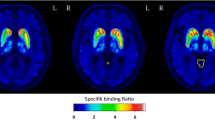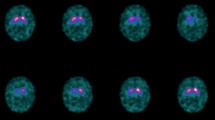Abstract
[123I]FP-CIT (N-ω-fluoropropyl-2β-carbomethoxy-3β-{4-iodophenyl}nortropane) has been developed successfully as a radioligand for single-photon emission tomography (SPET) imaging of dopamine transporters, which are situated in the membrane of dopaminergic neurons. Imaging of these transporters has shown promise as a clinical tool to detect degeneration of the dopaminergic nigrostriatal pathway. Several "presynaptic parkinsonian" syndromes, such as Parkinson's disease or multiple system atrophy, are characterised by degeneration of the nigrostriatal pathway. [123I]FP-CIT SPET imaging studies have shown the ability to detect loss of striatal dopamine transporters in such syndromes. However, in clinical practice it is sometimes difficult, but important, to discriminate patients with "presynaptic parkinsonism" from those with other forms of parkinsonism not characterised by loss of presynaptic dopaminergic cells (e.g. psychogenic parkinsonism or drug-induced postsynaptic parkinsonism). In these inconclusive cases, it may be of value to confirm or exclude the existence of degeneration of nigrostriatal dopaminergic cells by using imaging techniques such as [123I]FP-CIT SPET. Using [123I]FP-CIT SPET, we have imaged the striatal dopamine transporters in a group of patients with inconclusive forms of parkinsonism, and, moreover, have been able to perform clinical follow-up of these patients 2–4 years after imaging. In 33 inconclusive cases, ratios of specific to non-specific binding were calculated for the caudate nucleus and putamen following [123I]FP-CIT SPET imaging and compared with ratios obtained in healthy controls. In nine of the patients, degeneration of the nigrostriatal pathway was found scintigraphically and in all these cases, presynaptic parkinsonism was confirmed by clinical follow-up. In the other 24 subjects no degeneration was found scintigraphically. Forms of parkinsonism other than the presynaptic were confirmed at follow-up in 19 cases, and in three cases no conclusive diagnosis was established, but presynaptic parkinsonism was excluded clinically. A clinical diagnosis of presynaptic parkinsonism was established in two cases: one case of multiple system atrophy (in this patient loss of dopamine D2 receptors was found with [123I]iodobenzamide SPET performed 2 weeks after [123I]FP-CIT imaging) and one case of Parkinson's disease. Our data suggest that the positive predictive value of [123I]FP-CIT imaging is very high, and although the negative predictive value is lower, dopamine transporter imaging offers the prospect of a quick, objective method to confirm or exclude presynaptic parkinsonism in inconclusive cases.
Similar content being viewed by others
Author information
Authors and Affiliations
Additional information
Received 23 October and in revised form 5 December 2000
Electronic Publication
Rights and permissions
About this article
Cite this article
Booij, J., Speelman, J.D., Horstink, M.W.I.M. et al. The clinical benefit of imaging striatal dopamine transporters with [123I]FP-CIT SPET in differentiating patients with presynaptic parkinsonism from those with other forms of parkinsonism. Eur J Nucl Med 28, 266–272 (2001). https://doi.org/10.1007/s002590000460
Published:
Issue Date:
DOI: https://doi.org/10.1007/s002590000460




